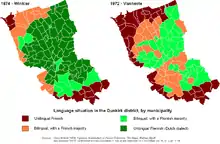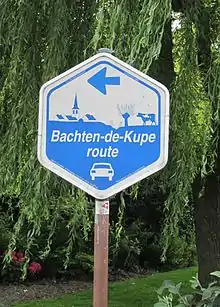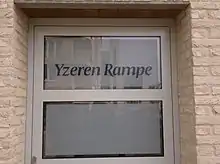West Flemish
West Flemish (West-Vlams or West-Vloams or Vlaemsch (in French-Flanders), Dutch: West-Vlaams, French: flamand occidental) is the name used to denote a group of dialects of Dutch spoken in western Belgium and adjoining parts of the Netherlands and France.[2] During the historical standardization process of the Dutch language as spoken in Belgium, it has been considered by some (such as Guido Gezelle) to be a separate Germanic language.
| West Flemish | |
|---|---|
| West-Vlaams | |
| West-Vlams, West-Vloams | |
| Native to | Belgium, Netherlands, France |
| Region | West Flanders |
Native speakers | 1.4 million (1998)[1] |
| Dialects | |
| Language codes | |
| ISO 639-3 | Either:vls – (West) Vlaamszea – Zeelandic (Zeeuws) |
| Glottolog | sout3292 Southwestern Dutch |
| Linguasphere | 52-ACB-ag |
West Flemish is spoken by about a million people in the Belgian province of West Flanders, and a further 50,000 in the neighbouring Dutch coastal district of Zeelandic Flanders (200,000 if including the closely related dialects of Zeelandic) and 10-20,000 in the northern part of the French département of Nord.[1] Some of the main cities where West Flemish is widely spoken are Bruges, Dunkirk, Kortrijk, Ostend, Roeselare, Ypres and Newport.
West Flemish is listed as a "vulnerable" language in UNESCO's online Red Book of Endangered Languages.[3] The language has its own dedicated Wikipedia.[4]
| This article is a part of a series on |
| Dutch |
|---|
| Dutch Low Saxon dialects |
| West Low Franconian dialects |
| East Low Franconian dialects |



Phonology
West Flemish has a phonology that differs significantly from that of Standard Dutch, being similar to Afrikaans in the case of long E and O, and where Standard Dutch has sch, Flemish, like Afrikaans, has sk. However, the best known traits are the replacement of Standard Dutch (pre-)velar fricatives g and ch in Dutch (/x, ɣ/) with glottal h [h, ɦ], and the overall lack of diphthongs. The following differences are listed by their Dutch spelling, as some different letters have merged their sounds in Standard Dutch but remained separate sounds in West Flemish. Pronunciations can also differ slightly from region to region.
- sch - /sx/ is realised as [ʃh], [sh] or [skʰ] (sh or sk).
- ei - /ɛi/ is realised as [ɛː] or [jɛ] (è or jè).
- ij - /ɛi/ is realised as [ɨ] (short ie, also written as y) and in some words as [ʉ].
- ui - /œy/ is realised as [ʉ] (short ie, also written as y) and in some words as [ɨ].
- au - /ʌu/ is realised as [ɔw] (ow)
- ou - /ʌu/ is realised as [ʊ] (short oe), it is very similar to the long "oe" that is also used in Standard Dutch ([u]), which can cause confusion
- e - /ɛ/ is realised as [æ] or [a].
- i - /ɪ/ is realised as [ɛ].
- ie - /i/ is longer [iː]
- aa - /aː/ is realised as [ɶː].
The absence of /x/ and /ɣ/ in West Flemish makes pronouncing them very difficult for native speakers. That often causes hypercorrection of the /h/ sounds to a /x/ or /ɣ/.
Standard Dutch also has many words with an -en (/ən/) suffix (mostly plural forms of verbs and nouns). While Standard Dutch and most dialects do not pronounce the final n, West Flemish typically drops the e and pronounces the n inside the base word. For base words already ending with n, the final n sound is often lengthened to clarify the suffix. That makes many words become similar to those of English: beaten, listen etc.
The short o ([ɔ]) can also be pronounced as a short u ([ɐ]), a phenomenon also occurring in Russian and some other Slavic languages, called akanye. That happens spontaneously to some words, but other words keep their original short o sounds. Similarly, the short a ([ɑ]) can turn into a short o ([ɔ]) in some words spontaneously, another phenomenon called okanye in Slavic languages.
The diphthong ui (/œy/) does not exist in West Flemish and is replaced by a long u ([ʉ]) or a long ie ([ɨ]). Like for the ui, the long o ([o]) can be replaced by an [ø] (eu) for some words but a [wo] for others. That often causes similarities to ranchers English.
Here are some examples showing the sound shifts that are part of the vocabulary:
| Dutch | West Flemish | English |
|---|---|---|
| vol (short o) | vul [vɐl] | full |
| zon (short o) | zunne [zɐn:ə] | sun |
| kom (short o) | kom* [kɔm] | come |
| boter (long o) | beuter [bøtər] | butter |
| boot (long o) | boot [bwot] | boat |
| kuiken | kiek'n [ki:ˀŋ] | chick |
| bruin | brun [brʉn] | brown |
- This is as an example as a lot of words are not the same. The actual word used for Kom is Menne.
Grammar
Plural form
Plural forms in Standard Dutch most often add -en, but West Flemish usually uses -s, like the Lower Saxon Germanic dialects and even more prominently in English in which -en has become very rare. Under the influence of Standard Dutch, -s is being used by fewer people, and younger speakers tend to use -en.
Verb conjugation
The verbs zijn ("to be") and hebben ("to have") are also conjugated differently.
| Dutch | West Flemish | English | Dutch | West Flemish | English |
|---|---|---|---|---|---|
| zijn | zyn | to be | hebben | èn | to have |
| ik ben | 'k zyn | I am | ik heb | 'k è | I have |
| jij bent | gy zyt | you are | jij hebt | gy èt | you have |
| hij is | ie is | he is | hij heeft | ie èt | he has |
| wij zijn | wydder zyn | we are | wij hebben | wydder èn | we have |
| jullie zijn | gydder zyt | you are | jullie hebben | gydder èt | you have |
| zij zijn | zydder zyn | they are | zij hebben | zydder èn | they have |
Double subject
West Flemish often has a double subject.
| Dutch | West Flemish | English |
|---|---|---|
| Jij hebt dat gedaan. | G' è gy da gedoan. | You have done that. |
| Ik heb dat niet gedaan. | 'K èn ekik da nie gedoan. | I didn't do that. |
Articles
Standard Dutch has an indefinite article that does not depend on gender, unlike in West Flemish. However, a gender-independent article is increasingly used. Like in English, n is pronounced only if the next word begins with a vowel sound.
| Dutch | West Flemish | English |
|---|---|---|
| een stier (m) | ne stier | a bull |
| een koe (f) | e koeje | a cow |
| een kalf (o) | e kolf | a calf |
| een aap (m) | nen oap | an ape |
| een huis (o) | en 'us | a house |
Conjugation of yes and no
Another feature of West Flemish is the conjugation of ja and nee ("yes" and "no") to the subject of the sentence. That is somewhat related to the double subject, but even when the rest of the sentence is not pronounced, ja and nee are generally used with the first part of the double subject. There is also an extra word, toet ([tut]), negates the previous sentence but gives a positive answer. It's an abbreviation of " 't en doe 't" - it does it.
Ja, nee and toet can also all be strengthened by adding mo- or ba-. Both mean "but" and are derived from Dutch but or maar) and can be even used together (mobatoet).
| Dutch | West Flemish | English |
|---|---|---|
| Heb jij dat gedaan? - Ja / Nee | Èj gy da gedoan? - Joak / Nink | Did you do that? - Yes / No |
| Je hebt dat niet gedaan, hé? - Maar jawel | G'èt da nie gedoan, é? - Batoet (kendoe) | You didn't do that, eh? - On the contrary (But yes I did.). |
| Heeft hij dat gedaan? - Ja / Nee | Èt ie da gedoan? - Joan / Nin (Joaj/Nij - Joas/Nis) | Did he do that? - Yes / No (Yes/No he - Yes/No she) |
| Gaan we verder? - Ja / Nee | Zyn we? - Jow / Niw | Can we go? - Yes / No |
Vocabulary
West Flemish inherited many words from Saxon settlers and later on had English loanwords from the wool and cloth trades. Both categories differ from Standard Dutch and show similarities with English and so is difficult to separate both categories.
During the Industrial Revolution, the increasing trade with France caused many industrial loanwords from French.
False friends
Even when words exist in both Dutch and West Flemish, their meaning can be different. That sometimes causes confusion for native speakers who do not realise that words are used differently.
| Dutch | West Flemish | English |
|---|---|---|
| achter | bachtn | after / behind (a notion of space) |
| na | achter | past / after (a notion of time) |
See also

- Flemish
- Dutch dialects
- Flemish people (Flemings or Vlamingen)
- French Flemish
- Hebban olla vogala
- Westhoek
References
- (West) Vlaams at Ethnologue (18th ed., 2015)
Zeelandic (Zeeuws) at Ethnologue (18th ed., 2015) - RL Trask, "Number of Languages", in Language and Linguistics: The Key Concepts, 2nd ed. 2007
- UNESCO.org Archived October 30, 2010, at the Wayback Machine
- "Voorblad". Wikipedia, the free encyclopedia. 2015-07-19. Retrieved 2018-06-08.
Further reading
- Debrabandere, Frans (1999), "Kortrijk", in Kruijsen, Joep; van der Sijs, Nicoline (eds.), Honderd Jaar Stadstaal (PDF), Uitgeverij Contact, pp. 289–299
External links
| Wikimedia Commons has media related to West Flemish language. |
| West Flemish edition of Wikipedia, the free encyclopedia |